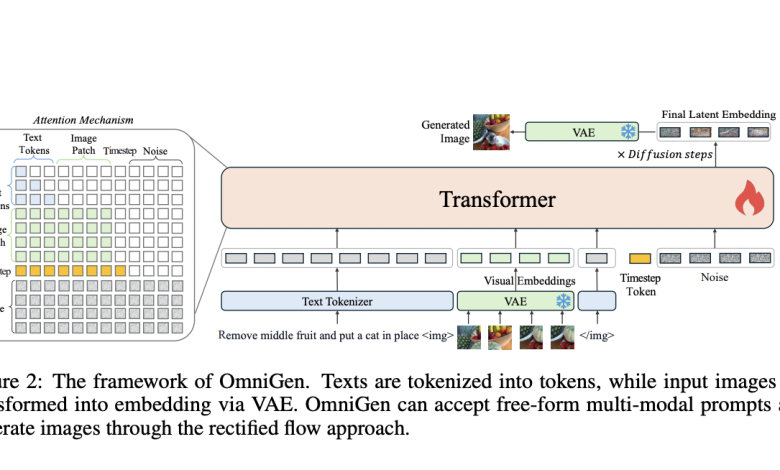OmniGen: A New Diffusion Model for Unified Image Generation

With the introduction of Large Language Models (LLMs), language creation has undergone a dramatic change, with a variety of language-related tasks being successfully integrated into a unified framework. The way people engage with technology has been completely transformed by this unification, opening up more flexible and natural communication for a wide range of uses. However, much research hasn’t been done on creating a similarly cohesive architecture that can manage several jobs within a single framework for image generation.
To fill this gap, a team of researchers from the Beijing Academy of Artificial Intelligence has developed OmniGen, a unique diffusion model created especially for unified image production. In contrast to other diffusion models like Stable Diffusion, which frequently need auxiliary modules like IP-Adapter or ControlNet to handle various control circumstances, OmniGen has been designed to work without these other parts. Because of its simplified methodology, OmniGen is a strong and adaptable solution for a variety of image creation applications.
Some key features of OmniGen are as follows:
- Unification: The capabilities of OmniGen extend beyond text-to-image generation. Numerous downstream tasks, such as picture editing, subject-driven generation, and visual-conditional generation, are naturally supported by it. It does not require additional models or add-ons to accomplish numerous complex jobs within a single model. OmniGen’s adaptability may be further demonstrated by applying its picture creation framework to applications such as edge detection and human pose identification.
- Simplicity: The streamlined architecture of OmniGen is one of its main benefits. OmniGen does not require extra text encoders or laborious preprocessing procedures, such as those required for human posture estimation, unlike many other diffusion models now in use. OmniGen’s simplicity makes it more approachable and user-friendly, enabling users to complete challenging image creation jobs with clear instructions.
- Knowledge Transfer: OmniGen can efficiently transfer knowledge between activities using its unified learning methodology. This feature demonstrates OmniGen’s versatility and capacity for innovation by allowing it to handle jobs and domains that it has never faced before. The development of a fully universal image-generating model is helped by the model’s capacity to transmit knowledge and adjust to new situations.
In order to improve OmniGen’s performance in challenging tasks, research has also been conducted on the reasoning abilities of the model and possible uses for the chain-of-thought process. This is essential because it creates new opportunities for the model to be applied to complex image production and processing jobs.
The team has summarized their primary contributions as follows.
- OmniGen, an innovative unified model with outstanding cross-domain performance for picture generation, has been introduced. It is competitive not just in text-to-picture creation but also supports other downstream functions such as subject-driven generation and controllable image generation. It is also capable of doing traditional computer vision tasks, which makes it the first image creation model with this level of capabilities.
- A large-scale picture production dataset known as X2I (“anything to image”) has been created. A wide range of image production tasks have been included in this dataset, all of which have been standardized into a single, unified format to enable consistent training and evaluation.
- OmniGen has demonstrated its versatility by using the multi-task X2I dataset for training, which allows it to apply learned information to previously unexplored tasks and domains.
Check out the Paper and GitHub. All credit for this research goes to the researchers of this project. Also, don’t forget to follow us on Twitter and join our Telegram Channel and LinkedIn Group. If you like our work, you will love our newsletter..
Don’t Forget to join our 50k+ ML SubReddit
Tanya Malhotra is a final year undergrad from the University of Petroleum & Energy Studies, Dehradun, pursuing BTech in Computer Science Engineering with a specialization in Artificial Intelligence and Machine Learning.
She is a Data Science enthusiast with good analytical and critical thinking, along with an ardent interest in acquiring new skills, leading groups, and managing work in an organized manner.



